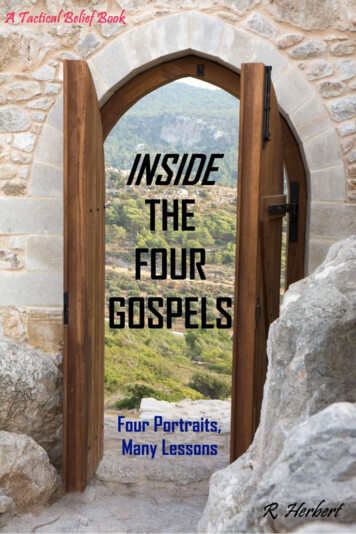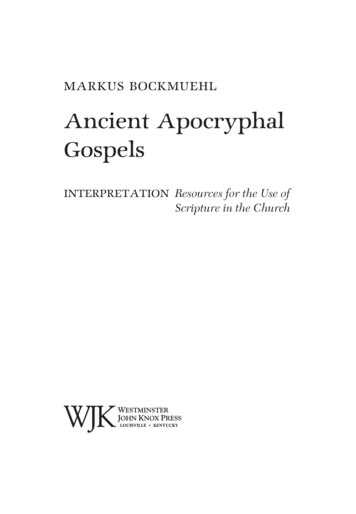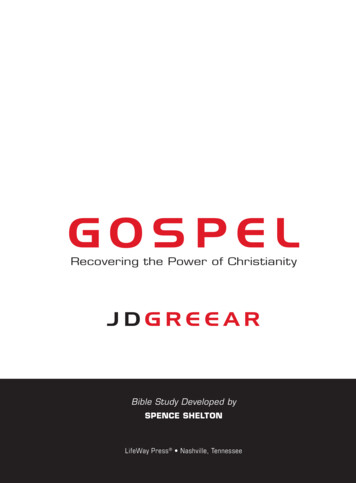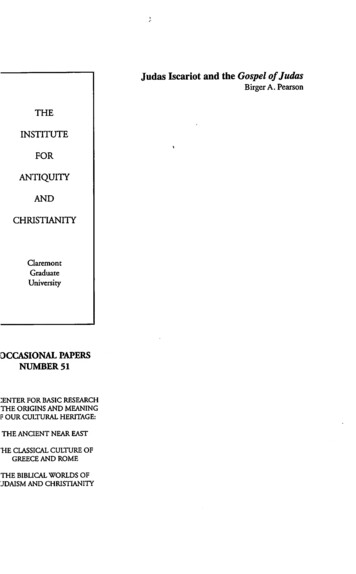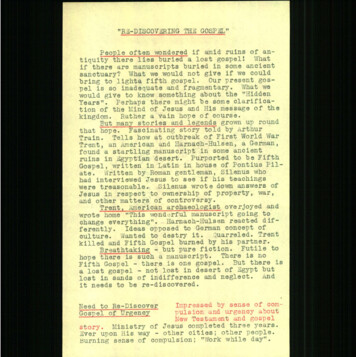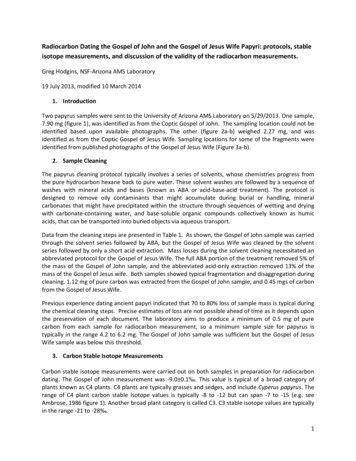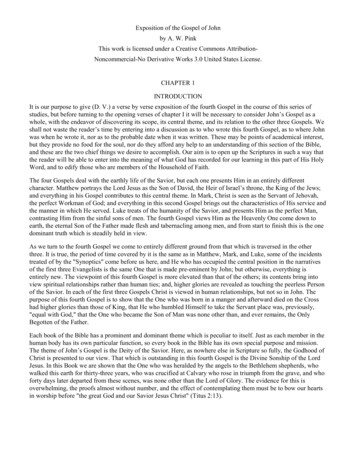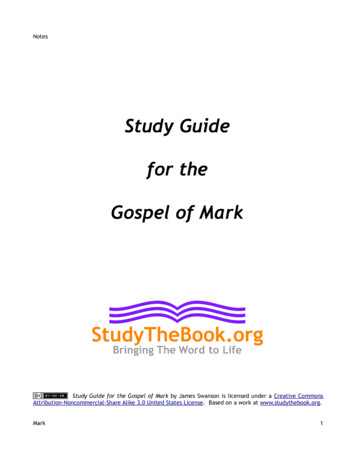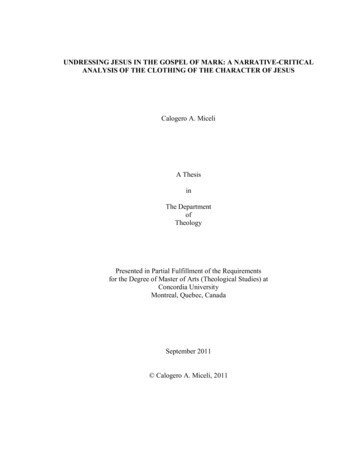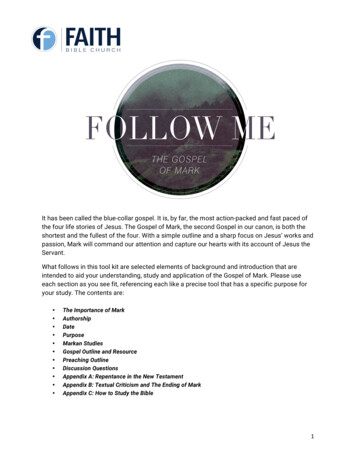
Transcription
It has been called the blue-collar gospel. It is, by far, the most action-packed and fast paced ofthe four life stories of Jesus. The Gospel of Mark, the second Gospel in our canon, is both theshortest and the fullest of the four. With a simple outline and a sharp focus on Jesus’ works andpassion, Mark will command our attention and capture our hearts with its account of Jesus theServant.What follows in this tool kit are selected elements of background and introduction that areintended to aid your understanding, study and application of the Gospel of Mark. Please useeach section as you see fit, referencing each like a precise tool that has a specific purpose foryour study. The contents are: The Importance of MarkAuthorshipDatePurposeMarkan StudiesGospel Outline and ResourcePreaching OutlineDiscussion QuestionsAppendix A: Repentance in the New TestamentAppendix B: Textual Criticism and The Ending of MarkAppendix C: How to Study the Bible1
The Importance of Mark“Without question, Mark’s Gospel is one of the most exciting and intriguing ofancient Christian documents.” (Ben Witherington III, The Gospel of Mark)“One can hardly exaggerate the significance of Mark’s Gospel for the ChristianChurch. From a literary standpoint, the evangelist’s designation of his work as the‘gospel of Jesus Messiah, Son of God’ (1:1) not only set in motion the process bywhich the first four books of the New Testament came to be known as ‘gospels’,but he most likely was the first to pen the story of Jesus. In fact, Mark’s Gospel maywell have spawned the writing of the other Gospels.” (Robert A. Guelich, WordBiblical Commentary: Mark 1:8-26)“In the early centuries of Christianity Mark’s Gospel was so overshadowed by itsmore ‘orderly’, fuller, and more theologically explicit neighbours that had it notbeen for its prestige as the gospel deriving from Peter it might well have fallen outof use altogether. Now that same gospel is everywhere praised for its powerfuland thought-provoking portrayal of Jesus, and (no doubt in large part owing to thegeneral modern view that it was the earliest gospel to be written) is theacknowledged starting point for most explorations of Christian origins.” (R. T.France, NIGCT: The Gospel of Mark)If, as we make the case for below, Mark’s Gospel was the first one written, likely only a coupleshort decades after Jesus’ ascension, then Mark represents the very first life-story of Jesus.The importance of a document like this cannot be overestimated. If the first, then Mark was alsolikely the first writing to be called a “gospel of Jesus Christ,” attributing the word “gospel” or“good news” to the incarnation, life, death and resurrection of the Son of God.As an unusually powerful modern-day anecdote, German classical scholar Gunther Zuntz relayshis first encounter with the Gospel of Mark. As a noted scholar deeply familiar with theliterature, history and context of the Roman Empire, Zuntz was, at the same time, quiteunfamiliar with Christianity and the Bible. His approach to Mark’s gospel was therefore as freshand unbiased as one could expect in our generation. The German scholar relates his “strongimpression” that “something very important was being put forward here with a superior purposeand concentration throughout the book The style and content of the story arouse a feeling ofotherness, a feeling that this is not a history like other histories, not a biography like otherbiographies, but a development of the actions, saying, and suffering of a higher being on his waythrough this anxious world of human beings and demons.” (Zuntz’ account translated by LucasGrollenberg, Messiah)Notice his concern with the content of Mark. It seems to be more than simply style, vocabularyor scope. Mark’s record of Jesus, Jesus’ works and undoubtedly His end were whatcharacterized this first reading. Imagine how it would have been for the first and secondgeneration Christians of Rome, having never been to Israel or heard some of the accountscontained in this Gospel record.2
Embarking on a study of Mark is not a simple enterprise. But neither is it deficient inChristological and theological value, historical weight, transforming power or worship catalyst.AuthorshipNone of the four Gospels in our canon reveal their author’s name. It is not until the first half ofthe second century (A.D. 110-150) that titles appear on each of the four, assigned largely on thebasis of church tradition, likely to preserve for subsequent generations what this first generationknew implicitly. Since many Jesus and church-focused books, letters and biographies werewritten just after Jesus’ resurrection, it became paramount that priority of emphasis be given tothose writings directly connected to an eye-witness apostle or the close associate of an apostle.This also played a role in recognizing the inspiration of the Holy Spirit as the official collectionof New Testament books became obvious and officially agreed upon. Since Mark is not amongthe twelve apostles mentioned in the Gospels and Acts, where does this title come from?Fortunately, early church history and specifically the writings of the early church “fathers”provide tremendous help. Church Fathers refers to many generations of church leaders aroundthe Mediterranean area and beyond that began with the disciples of Jesus’ disciples. Theyquickly became the most influential leaders, preachers and authors of the church for amillennium. The first reference to the author and setting of the Second Gospel comes from oneof these leaders, an early church bishop named Papias who served as a pastor of Hierapolis, acity in modern-day Turkey. Papias died in A.D. 130. Preserved by another church father namedEusebius in a quote, Papias writes:Mark became Peter’s interpreter and wrote accurately all that he remembered, not,indeed, in order, of the things said or done by the Lord. For Mark had not heard the Lord,nor had he followed him, but later on, as I said, followed Peter, who used to give teachingas necessity demanded but not making, as it were, an arrangement of the lord’s oracles,so that mark did nothing wrong in thus writing down single points as he rememberedthem. For to one thing he gave attention, to leave out nothing of what he had heard and tomake no false statement in them. (Eusebius, History of the Church)Among other corroborating evidence, this quote reveals our first main point: Mark’s Gospel isdirectly connected to the eyewitness account of the apostle Peter. This understanding seems tobe rather full and unanimous among the church writings of this era. Another church pastornamed Clement of Alexandria also weighs in, again recorded by Eusebius:When Peter had publicly preached the word at Rome, and by the Spirit had proclaimed theGospel, that those present, who were many, exhorted Mark, as one who had followed[Peter] for a long time and remembered what had been spoken, to make a record of whatwas said; and that he did this, and distributed the Gospel among those that asked him.(Eusebius, History of the Church)But who is this Mark who was a follower or disciple of Peter? Since the title given wasunelaborated, this Mark seems to have been implicitly known or identified among the earlychurch. The man generally associated with this work is the John Mark of Acts 12:12; Acts3
13:13f; Colossians 4:10; Philemon 24; 2 Timothy 4:11 and 1 Peter 5:13. Most scholars agreethat John Mark seems to be the most logical and contextual choice. I agree.According to early church tradition, Mark preached the gospel in Egypt after his time in Romeand established several churches, eventually becoming the first bishop of Alexandria. Evidently,John Mark’s mother was named Mary, in whose home the early church gathered in Jerusalem.This is also the probable location of the Last Supper (Acts 1:13-14; Mark 14:14).“Another important source of the tradition that Mark wrote this Gospel is the AntiMarcionite Prologue to Mark (A.D. 160-180). It also stated that Mark received hisinformation from Peter. Moreover, it recorded that Mark wrote after Peter died, and that hewrote this Gospel in Italy. Irenaeus (ca. A.D. 180-185), another early church father, notedthat Mark wrote after Peter and Paul had died (Against Heresies, 3:1:2). Other earlytradition documenting these facts comes from Justin Martyr (ca. A.D. 150-160), Clementof Alexandria (ca. A.D. 195), Tertullian (ca. A.D. 200), the Muratorian Canon (ca. A.D. 200),and Origen (ca. A.D. 230). This testimony dates from the end of the second century.Furthermore it comes from three different centers of early Christianity: Asia Minor(modern Turkey), Rome (in Italy), and Alexandria (in Egypt). Thus there is strong externalevidence that Mark wrote this Gospel.” (Constable, soniclight.com)Furthermore, the testimony of the early church relates the Gospel being written from and to theGentile believing residents of Rome. Irenaeus, yet another church bishop pasturing in thesecond century, relates that after Peter and Paul had both preached the Gospel of Jesus Christin Rome, and perhaps even after they gave their lives for the same cause, “Mark, the disciple andinterpreter of Peter, also himself handed on in writing the things that had been preached byPeter.” (Irenaeus, Against Heresies)This concludes the three major points that should be noted in this section: the Second Gospelrecords the eyewitness account of the apostle Peter, was written at the hand of John Mark andwas written from and for the residents of Rome.DateThe date of authorship of Mark’s Gospel is, of course, as detailed and difficult as the subject ofauthorship itself. Dating of New Testament books must take into account several factors.Obviously the life span of the author is first. Peter died around A.D. 67 in Rome. But since JohnMark wrote down the eyewitness account of Peter, it is possible the final form of the Gospelcame later than 67.Roman history is also a key factor. The great fire in Rome in A.D. 64, likely at the hand ofEmperor Nero himself, then blamed on the Christians, is an important marker in the discussionof Mark’s date. The great persecutions that followed the fire seem to greatly influence andperhaps even be alluded to by some of the contents of Mark. The Suffering of Jesus the Servantwould have been a powerful encouragement to the suffering Roman Christians under Nero.Furthermore, there seems to be no direct or powerful reference to the total destruction ofJerusalem under General Titus in A.D. 70. This is not an argument from silence, but rather a4
powerful argument about silence. Mark, nor any New Testament book, explicitly mentions thiscatastrophic event as a point of history. Therefore the authorship of Mark likely falls betweenthe fire of 64 and the collapse of Jerusalem in 70. I prefer a date early in this range, likely aroundA.D. 65-66, although it is possible that the true date is a decade or more earlier than this.PurposeIt seems clear from even a simple reading of Mark’s Gospel that his purpose was also simple.While specific weight is given to characterization of Jesus as a God’s Suffering Servant, thegeneral purpose seems to be to record a relatively short life story of Jesus, the Christ. Thegenre, or literary type, of Mark is most closely related to the Greek bios or life story, life account.All four gospels relate closely to the Greek bios. And while strict chronology, from our modernperspective, was not an ideal or value, the events and wording included, as well as the myriadevents and wording excluded, were seemingly collated with this simple goal in mind: painting anaccurate picture of Jesus, the Messiah, God’s Son, for broad usage. Moreover, matters ofpurpose invariably relate to matters of audience and setting. This helps us revise and sharpenMark’s simple purpose into a more specific one.“The traditional view that mark was written in Rome toward the end of orshortly after the Jewish war is still the most probable setting for this Gospel.Wherever it was composed, Mark should be read as a pastoral response tostressful times. The church faced major crises in the 60s. Christians had to copewith the death of eyewitnesses, which created the need to conserve and stabilizetraditions about Jesus. We learn from Tacitus that the church in Rome wassubject to vicious gossip and hostility (see also 1 Peter 2:15; 3:13-16; 4:12) andneeded to fend off attacks from various quarters. Christians had to deflectgovernment suspicion of them as a potentially subversive group. They also hadto defend themselves against religious rivals who would foil the church’s growth.What did Christians know of the origin of their faith? How could they respondconfidently to the misrepresentations without knowing or having an account ofwhat happened to their Founder, who was executed by sentence of a Romanmagistrate? Mark compiled a written record of the preaching of Peter andperhaps others to edify the church and to aid it in the task of proclaiming thegospel in the Greco-Roman world.Mark also composed his Gospel to encourage Christians facingincreasingly trying conditions and to remind them of the foundation of their faith.Except for isolated local confrontations, Christian were relatively ignored untilA.D. 64. Things changed dramatically, however, after a disastrous fire sweptRome that year. Then of the city’s fourteen wards were destroyed. After the initialshock, rumors began to fill the still smoky air that the fire had been part of Nero’surban renewal scheme. Nero attempted to squelch the rumors with a program oftax relief, food giveaways, and rebuilding. When the gossip persisted, he found ascapegoat in the Christians. Tacitus [the Roman historian] reports [in brutallyexplicit detail]:5
“Neither all human endeavor, nor all imperial largess, nor all the modes ofplacating the gods, could stifle the scandal or banish the belief that the [greatRoman] fire had taken place by order. Therefore to scotch the rumor, Nerosubstituted as culprits, and punished with the utmost exquisite cruelty, a classloathed for their abominations, whom the crowd styled Christians. Christus, fromwhom the name is derived, had undergone the death penalty in the reign ofTiberius, by sentence of the procurator Pontius Pilate. Checked for the moment,this pernicious superstition again broke out, not only in Judea, the home of thedisease, but in the capital itself [Rome] – that receptacle for everything hideousand degraded from every quarter of the globe, which there finds a vogue.Accordingly, arrest was first made of those who confessed [to being Christians];next, on their disclosures, vast numbers were convicted, not so much on thecharge of arson as for hatred of the human race. Every sort of derision wasadded to their deaths: they were wrapped in the skins of wild beasts anddismembered by dogs, others were nailed to crosses; others when daylight failed,were set afire to serve as lamps by night. Nero had offered his garden for thespectacle and gave an exhibition in the circus, mingling with the people in thecostume of charioteer or mounted on a car. Hence even for criminals whomerited extreme and exemplary punishment, there arose a feeling of pity, due tothe impression that they were being destroyed, not for the public good, but togratify the cruelty of a single man.” (Tacitus, Annals 15.44) (David Garland, Mark,the NIV Application Commentary: 28-29)Markan StudiesFor far too long, scholarly attention and study of Mark was woefully lacking. This is dueprimarily to some commonly held conclusions in what is called the “Synoptic Problem.” TheSynoptic Gospels (syn together or the same, optic seeing) are those that see the life of Jesusin generally the same way, Matthew, Mark and Luke. John, the Fourth Gospel, is very obviouslydifferent than the other three. It has a different structure, language, content and explicit purpose(20:31). Leaving John for a moment, studies of the three Synoptic Gospels have, for centuriesnow, included an ongoing conversation about content and chronological order or priority. Inother words, which one came first? And how do the other two relate to the first one?Combine this with the overwhelming overlap between the three and the problem, or as I like tocall it, the “Synoptic Question” becomes apparent. For example, how much of the content ofMark do you think is found in Matthew, in many cases word for word? The answer is just fivepercent less than one hundred percent! There is less, but still substantial overlap between Markand Luke. In fact, the only passages in Mark not found in Matthew, Luke or both are Mark 4:2629; 7:31-37 and 8:22-26. Sixteen verses!Primarily with regard to the First Gospel scholars felt obliged to make a decision about priority.Since 95% of Mark is in Matthew, for most of recent times, Mark has been understood as adistillation or abbreviation of Matthew. In other words, Matthew was written first and then Mark6
came along as the cliff notes version. Recently, however, the tables have turned. For over acentury now, new looks at Mark have uncovered convincing reasons why the Second Gospelshould be considered first in priority (the first one written). This change of view, to which I amvery sympathetic, has boosted Markan studies to celebrity proportions.Gospel Outline and ResourceBuilding on the great work of others, I maintain the case that the Gospel of Mark can be easilydivided into two sections, with a third pivot section in the middle. Ben Witherington’s great workon Mark illustrates this simple outline.Thus I would suggest that the structure of Mark’s Gospel divides rather neatlyinto several parts. The first part emphasizes the raising of questions aboutJesus, such as the following:1:27 – What is this? A new teaching with authority (crowd)2:7 – Why does this fellow speak this way? Who can forgive sins? (Scribes)2:16 – Why does he eat with sinners? (Scribes)2:24 – Why are they doing what is not lawful? (Pharisees)4:41 – Who, then, is this, that even wind and waves obey him? (Disciples)6:2 – Where did this man get this wisdom? (hometown folks)7:5 – Why do your disciples not live by tradition? (Pharisees) Thus we may present Mark’s outline as follows:The questions – Who and why? – 1-8:27The who question answered – Peter’s confession of faith: Jesus is the Christ –8:27-30What is the mission? – A mission of suffering – 8:31; 9:31; 10:32Mission accomplished – The Passion narrative – 11-16(The Gospel of Mark, p.37-38)R. T. France divides the book similarly (NICGNT, Mark, p.13-14).o 1:1-8:21 – Heading, Prologue and ACT ONE: Galileeo 8:22-10:52 – ACT TWO: On the Way to Jerusalemo 11:1-16:8 – ACT THREE: JerusalemThe text of Mark obviously turns on Peter’s statement in 8:29. Allowing that small event to bethe pivot point, we will be working with the simplest version of the outline. 1:1-8:26 – Who is Jesus and Why is He important? – DISCOVERYo 8:27-30 – You are the Christ! – EXCLAMATION 8:31-16:20 – What and How will Jesus accomplish His mission? – PASSIONIf you would like more detailed introductory and background material, or perhaps verse by versehelp through the Gospel of Mark, I would recommend www.Soniclight.com. These free StudyNotes on every book of the Bible are written and constantly updated by DTS professor Dr. TomConstable. They are accessible to all levels and represent a theology of free grace.7
Preaching OutlineFor our purposes in the life of the Faith Bible Church family, we have scheduled our time in Markthrough the following sections, Lord willing. These are subject to change and are listed here asa potential help to small group studies or family discussion plans. There will be severalimportant “interruptions” to the following schedule for Missions Sundays, the ChristmasSeason etc.Sermon Passages:1:1-8 – Introduction to Gospel (Started April 12, 2015)1:9-15 – Baptism and temptation1:16-28 – Disciples and Capernaum synagogue1:29-45 – Healings and Galilee synagogue2:1-12 – Healing and conflict2:13-22 – Levi, feasting and fasting2:23-3:6 – Sabbath and healing3:7-19 – Retreat, healing and Discipleship3:20-35 – Family and Satan teaching4:1-20 – Parables4:21-34 – Parables4:35-41 – Stilling the sea5:1-20 – Demoniac healed5:21-43 – Healings6:1-6a – Rejection in Nazareth6:6b-13 – Twelve sent out6:14-32 – Twelve recalled6:33-56 – Water walk and healing7:1-23 – Tradition and hand washing7:24-37 – Gentile healings8:1-26 – 4000 fed and Pharisees8:27-33 – Peter’s confession – Center point of Gospel8:34-9:1 – Discipleship9:2-13 – Transfiguration9:14-29 – Healing and demons9:30-37 – Discipleship and servanthood9:38-50 – Dense teaching10:1-16 – Divorce and children10:17-31 – Rich Young Ruler and discipleship10:32-52 – Death and Kingdom and healing of Bartimeaus11:1-19 – Palm Sunday and cleansing11:20-12:12 – Prayer, faith and authority12:13-44 – Controversy and questions13:1-37 (2 weeks) – The last days8
14:1-11 – Bedikat Hametz and anointing14:12-42 – Last Supper and Garden14:43-72 – Betrayal, arrest and denials15:1-21 – Pilate and Scourging15:22-47 – Cross, death and burial16:1-20 – Resurrection and commissionDiscussion QuestionsThe following questions for Mark are quoted directly from the great work of Warren Wiersbe inthe “Be” Series of Chariot Victor Publishing. His work on the Gospel of Mark is entitled BeDiligent (1987).Mark Chapter 11. What about Jesus’ life shows you His servant spirit?2. Define the Roman’s struggle to accept that Jesus was the Son of God.3. List three points in Mark’s gospel regarding the Good News.4. How did Jesus’ baptism reflect His role as a servant?5. List some ways that Jesus’ temptation reveals His servanthood?6. What does a person’s sense of authority reveal about his servanthood?7. When Jesus expressed His authority over demons, what did the people watching learnabout Him?8. When Jesus healed the people around Him of their illnesses, what did they learn of Hisservanthood?9. In what ways can we be servants like Jesus?Mark 2:1- 3:121. What kinds of things stand in the way of us following Jesus’ example of taking time for prayer?2. Name some things that prayer time accomplishes in our lives?3. What inspires you most about the account of the four men who lowered their friend through theroof so Jesus could heal him?4. In this account, what relationship did Jesus forgiving the man’s sin have with healing his body?5. Jesus chose to befriend the unlovable. How can we practice this in our relationships?6. List some ways that becoming a Christian is much like saying “I do” in a wedding ceremony.7. In what ways is Christianity distinctive from the world religions of our day?8. Wiersbe wrote” “Salvation is not a partial patching up of one’s life; it is a whole new robe ofrighteousness.” Describe what partially patching up one’s life is like.9. Jesus broke traditions such as not working on the Sabbath. Why do you think he felt free todo that?10. In some ways Jesus was leading a rebellion against traditional religion. How would you describeJesus’ rebellion?Mark 3:13 - 4:341. List some of the differences between being a celebrity and being a servant.2. What do you think made the disciples respond to Jesus and walk away from their lives?3. If becoming a Christian is like becoming a part of a new family, what responsibilities go alongwith that?9
4. The Jews of Jesus’ day thought that He was coming to set us a political kingdom. Describe thekind of kingdom that Jesus came to set up instead?5. Name some reasons that the religious leaders of Jesus’ day were so threatened by Hispopularity.6. Why were parables a powerful way for Jesus to teach?7. As you look at the church in our nation today, which of the seed/hearts in the Parable of theSower would you compare your faith to: hard hearts, shallow hearts, crowded hearts, or fruitfulhearts? Why?8. List some ways that our lives are like the oil lamp in Jesus’ parable in Mark 3:21.9. Describe a time when you saw something happen that you believe was Satan moving against thework of Christ.10. How do you think Jesus would invite someone, in today’s language, to join God’s family?Mark 4:35 – 5:431. How can you explain the fact that the disciples saw Jesus do miracles and heard Him teach, yetwere surprised that He could still the storm?2. Why are we often amazed when we pray for something and God answers?3. Discuss some reasons why difficult circumstances cause us to doubt God’s care for us?4. If we had and easy life, with no trials, do you think our faith would blossom more?5. Wiersbe notes that Satan took away everything from the men his demons possessed: their jobs,their family, their friends. In what situations do you see Satan doing that today?6. Discuss the courage and faith you think was involved for the sick woman to push through thecrowd and believe Jesus could heal her.7. If you had been Jairus, standing and waiting for Jesus to come see about your daughter, howwould witnessing this woman’s healing have affected you?8. What kind of faith did it take for Jairus to keep believing Jesus could make a difference even afterhe heard that his daughter was dead?9. As Jesus traveled through crowds of needy people, how do you think He decided who torespond to?Mark 6:1-561. How do you define what it means to believe in something or someone?2. From what you remember about Jesus’ life, what would have convinced you that you couldbelieve He was truly the Son of God?3. What dynamics of a “hometown” would have made it difficult for the people of Nazareth to takeJesus seriously?4. If you have been from Nazareth, what would have been your greatest challenge in acceptingJesus as the Son of God?5. What do you think would have been the greatest difficulty in being a disciple of Jesus?6. What do you think would have been the greatest joy in being a disciple of Jesus?7. To what contemporary evil or notorious character would you compare the wife of Herod whorequested John the Baptist’s head on a platter? Explain.8. Make a list of what Jesus taught about God’s nature when He fed the 5,000 hungry people withonly a small lunch.9. What kinds of things did Jesus teach the disciples about God’s nature when He walked acrossthe water to their boat during a storm?10. How would you define the connection between Peter’s faith and his ability to walk across water?10
Mark 7:1 – 8:261. The servanthood of Jesus Christ stood in sharp in contrast to the religious leaders of His day,who used their positions to gain power over the people. In what ways do we see that sameproblem today?2. On a scale of 1-10 (1 extremely difficult, 10 extremely easy) how easy do you think it is to obeyGod outwardly through ceremony, and yet be disobedient in your heart attitude? What spiritualproblem does this create?3. What are the positive effects of longtime traditions?4. What are the negative effects of longtime traditions?5. What hypocrisies do you see around you that Jesus would have rebuked?6. How often do you think God’s truth conflicts with the traditions in the church?7. Wiersbe says: “Great faith is faith that takes God at His Work and will not let go until God meetsthe need.” Describe an act of great faith that you have seen or heard about or experienced.8. Through His miracles Jesus helped people solve the problems they faced. What does this teachus about how Jesus can help us face our own problems?9. Even though the disciples witnessed the miracles of Jesus, they were still afraid when they facedtrials. If God has come through for us in our lives, why do we still worry when problems arise?10. How is false doctrine like leavening in bread?Mark 8:27 – 9:501. If you had been allowed to sit in on one of Jesus’ private sessions with His disciples, whatquestions would you ask Him?2. Why do you think many peopled failed to understand that Jesus was God’s Son, even when theywitnessed His miracles?3. If you had been among the disciples when Jesus told them of His impending death, what kind ofthoughts would have run through your mind”4. What was the relationship in Jesus’ life between “suffering” and “glory”?5. Wiersbe says that Jesus knew the crowds were following him just because of his miracles. Forwhat reason would Jesus rather have them follow Him?6. What is the cost of being a disciple of Jesus?7. Describe a mountaintop experience you have had that make you feel, like Peter, as if you justwanted to stay in that place and never leave.8. Read Mark 9:24 and describe a time that you came to God with a need as much as this fathercame to Jesus. What was the result of your petition?9. Jesus used a child to teach a lesson on humility. When you watch a child, what do you seereflected of the humble, servant life that Jesus taught?Mark Chapter 101. How would you describe our current society’s view of divorce?2. How did Jesus’ mention of the wife in His directive on divorce elevate the status of women in thatsociety?3. What have the children in your life taught you about following God?4. In Jesus’ day, to not have children was a shame and a curse and to have them was a blessing.How does that compare with our view of children today?5. Wiersbe says that the young ruler from Mark 10 “measured obedience only by external actionsand not by inward attitudes.” What is the appropriate way to measure obedience?6. What is the most important lesson you’ve learned about money and its priority in your life?11
7. In hindsight, it seems implausible that, in the face of Christ’s servant leadership, the disciplescould squabble over who would be the most important. From what you know of human nature,though, how do you imagine it happened?8. Why does a person with a servant heart make the best leader?9. If Jesus asked you the question that He asked Bartimaeus, “What do you want Me to do for you?”what would you answer?Mark 11:1 – 12:441. Jesus’ message and presence conflicted with birth the religious and political leaders of his day.In what ways is that still true today?2. The people who welc
! 2! The Importance of Mark "Without question, Mark's Gospel is one of the most exciting and intriguing of ancient Christian documents." (Ben Witherington III, The Gospel of Mark) "One can hardly exaggerate the significance of Mark's Gospel for the Christian Church. From a literary standpoint, the evangelist's designation of his work as the
